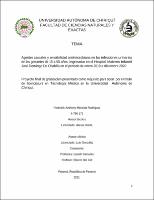Mostrar el registro sencillo del ítem
Agentes causales y sensibilidad antimicrobiana en las infecciones urinarias de las gestantes de 15 a 50 años, ingresadas en el hospital materno infantil José Domingo De Obaldía en el periodo de enero 2019 a diciembre 2020.
| dc.contributor.advisor | González, Luis | |
| dc.contributor.advisor | Ureña, Alexis | |
| dc.contributor.advisor | Samudio , Lisseth | |
| dc.contributor.advisor | Del Cid, Eliecer | |
| dc.contributor.author | Miranda Rodríguez, Roderick Anthony | |
| dc.date.accessioned | 2022-03-14T19:21:12Z | |
| dc.date.available | 2022-03-14T19:21:12Z | |
| dc.date.issued | 2021 | |
| dc.identifier.uri | http://jadimike.unachi.ac.pa/handle/123456789/288 | |
| dc.description.abstract | Urinary tract infection is the most frequent bacterial infection observed in the outpatient setting: 1 in 3 women will develop a urinary infection that will require treatment with antibiotics before the age of 24 years and, at least, 50% a tract infection urinal throughout your life. Objective: To identify the frequencies and evaluate the antimicrobial sensitivity of urinary tract infections in the Obstetrics and Gynecology ward of the José Domingo De Obaldía Maternal and Child Hospital from January 2019 to December 2020. Materials and methods: Retrospective, observational and analytical. Data will be taken from 200 hospitalized pregnant patients who attended the José Domingo De Obaldía Maternal and Child Hospital, which will be divided into groups depending on the causal agents of urinary tract infections. For the statistical analysis, the IBM SPSS Statistics program will be used, which will be entered to obtain the percentage and graphs and tables of the microorganisms obtained from pregnant patients in the Gynecology - Obstetrics ward. Results: The 2019- 2020 period comprised the time of this study, which included 200 pregnant patients from the José Domingo De Obaldía Maternal and Child Hospital, with symptoms of urinary infection, which is verified with positive urine culture results, in which The frequency and percentages of causative agents of these infections were evaluated in addition to the sensitivity and resistance to antibiotics carried out in the antibiogram. The most frequently isolated etiological agent was Escherichia coli with 42.5% of the cases, followed by Klebsiella spp with 25% and Proteus spp with 8.5%. Conclusion: The highest percentage of urinary infections was caused by Escherichia coli; the most frequent age of onset between the ages of 20 to 50 years and the antibiotics that presented greater resistance were Trimethropin sulfamethoxazole and Ciprofloxacin in 2019. | es_ES |
| dc.description.abstract | La infección del tracto urinario es la infección bacteriana más frecuente observada en el ámbito ambulatorio: 1 de cada 3 mujeres desarrollará una infección urinaria que requerirá tratamiento con antibióticos antes de los 24 años y, al menos, el 50% una infección del tracto urinario durante su vida. Objetivo: Identificar las frecuencias y evaluar la sensibilidad antimicrobiana de las infecciones de vías urinarias de la sala de Obstetricia del Hospital Materno Infantil José Domingo De Obaldía entre enero de 2019 a diciembre de 2020. Materiales y métodos: Retrospectivo, observacional y analítico. Se tomaran datos de 200 pacientes gestantes hospitalizadas que acudieron al Hospital Materno Infantil José Domingo De Obaldía, los cuales serán divididos en grupos dependiendo de los agentes causales de infecciones en las vías urinarias. Para el análisis estadístico se hará uso del programa IBM SPSS Statistics, en el cual se ingresará para obtener el porcentaje y gráficas y tablas de los microorganismos obtenidos de las pacientes gestantes de la sala de Obstetricia. Resultados: El periodo de 2019- 2020 comprendió el tiempo de este estudio, el cual se incluyó a 200 pacientes gestantes del Hospital Materno Infantil José Domingo De Obaldía, con síntomas de infección urinaria, que se comprueba con resultados de urocultivos positivos, en el cual se evaluó la frecuencia y porcentajes de agentes causales de estas infecciones además la sensibilidad y resistencia a los antibióticos realizado en el antibiograma. El agente etiológico más frecuentemente aislado fue Escherichia coli con 42,5 % de los casos, seguido por Klebsiella spp con 25% y Proteus spp con 8.5%. Conclusión: El mayor porcentaje de infecciones urinarias fue causado por Escherichia coli; la edad más frecuente de aparición entre las edades de 21 a 29 años y los antibióticos que presentaron mayores resistencia fue el Trimetropin- sulfametoxazol y Ciprofloxacina en el 2019. | |
| dc.description.tableofcontents | CAPITULO I. MARCO INTRODUCTORIO…………………………………8 1. Introducción………………………………………………………………….8 1.1. Aspectos generales del problema………………………………………….10 1.2. Objetivo general…………………………………………………………..11 1.3. Objetivos específicos……………………………………………………...11 1.4. Limitaciones…………………………………………………………….. 12 1.5. Justificación……………………………………………………………... 12 CAPÍTULO II. MARCO TEÓRICO………………………………………… 14 CAPÍTULO III. MATERIALES Y MÉTODOS……………………………...44 CAPÍTULO IV. Resultados…………………………………………………..49 Discusión de Resultados………………………………………………………59 CAPÍTULO V. Consideraciones finales……………………………………..66 5.1 Conclusiones………………………………………………………………66 5.2 Recomendaciones………………………………………………………….67 | |
| dc.language.iso | es | es_ES |
| dc.publisher | Universidad Autónoma de Chiriquí. | es_ES |
| dc.subject | INFECCIONES DEL TRACTO URINARIO | |
| dc.subject | ANTIBIÓTICOS | |
| dc.subject | AGENTES ANTIBACTERIALES | |
| dc.subject | ESCHERICHIA COLI-CONTROL | |
| dc.subject | ORINA-ANÁLISIS | |
| dc.subject | INFECCIONES URINARIAS | |
| dc.title | Agentes causales y sensibilidad antimicrobiana en las infecciones urinarias de las gestantes de 15 a 50 años, ingresadas en el hospital materno infantil José Domingo De Obaldía en el periodo de enero 2019 a diciembre 2020. | es_ES |
| dc.type | Thesis | es_ES |

